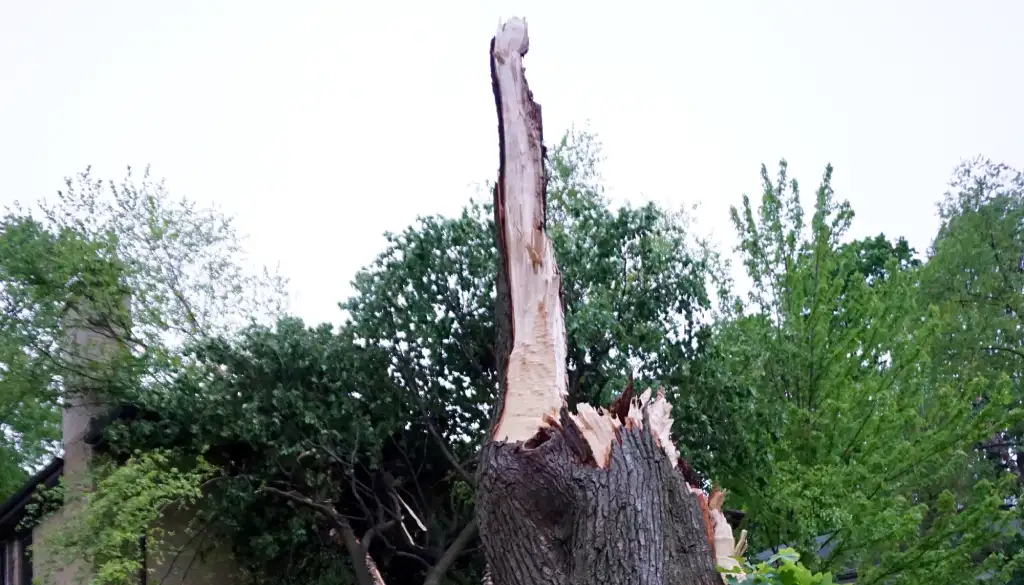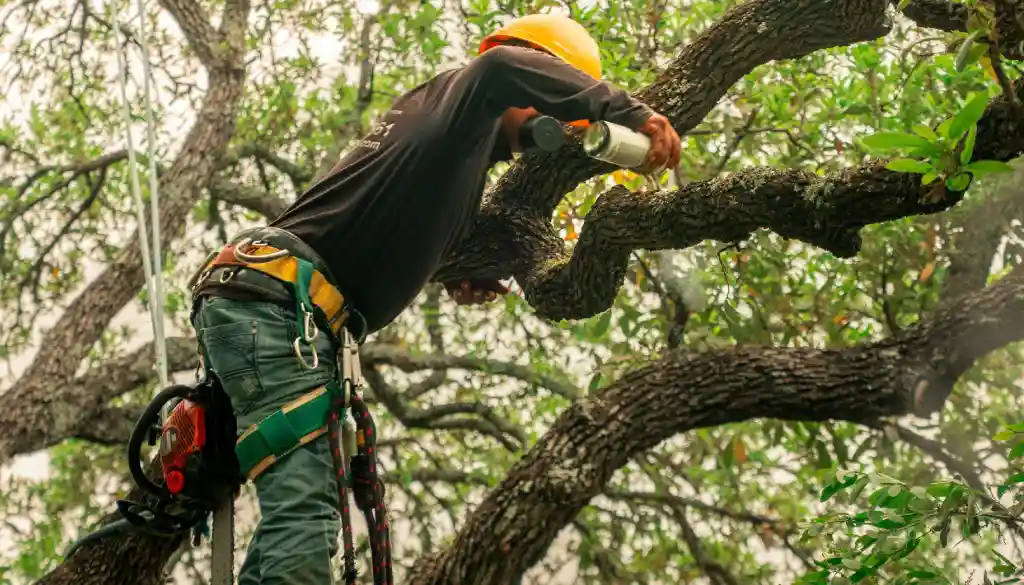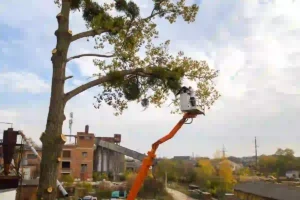Homeowners regularly face $8,000 fines for cutting down dead trees without HOA approval. Recently, a Phoenix family had to replant three $2,500 oak trees because their HOA required two-for-one replacement after removing storm-damaged pines.
HOA tree restrictions are getting stricter and penalties are getting more expensive. Understanding the system helps homeowners work within community guidelines without breaking their budgets.
Here’s what homeowners need to know before touching any tree in an HOA-controlled community.
The Real Cost of HOA Violations
A Scottsdale family faced $15,000 in fines for removing three mesquite trees without approval. The HOA sued them in small claims court and won. The trees were dead from drought stress, but that didn’t matter to the architectural review board.
Fines typically start at $100 per day and escalate to $500 daily after 30 days. A simple tree removal that should cost $800 can turn into $15,000 in fines plus legal fees if homeowners skip the approval process.
Insurance doesn’t cover HOA violation fines. Homeowners pay these costs out of pocket, and many HOAs can place liens on properties for unpaid fines.
Violations aren’t just about money. HOA violations create permanent records that affect property sales and refinancing. They also strain neighbor relationships and community harmony.
What CC&Rs Actually Say About Trees
Most homeowners never read their CC&Rs until they’re facing violations. These documents control what residents can do with every tree on their property, sometimes down to specific species and sizes.
One Ahwatukee HOA prohibits any tree taller than the roofline. A North Scottsdale community requires written approval to trim anything larger than pencil-thick branches. These aren’t unusual rules.
Homeowners should highlight every tree-related sentence in their CC&Rs. Look for phrases like “architectural approval required,” “landscape modifications,” or “vegetation removal.” These seemingly innocent words can cost thousands if ignored.
Pay special attention to amendment dates. Many communities have added stricter tree rules over the past decade. CC&Rs from 2010 might not include 2023 tree restrictions that still apply to properties.
The Approval Process Reality
Most HOAs meet once monthly. Miss the submission deadline and homeowners wait another month. Need three board members present for a quorum but only two show up? Wait another month.
One homeowner waited seven months for approval to remove a diseased palm tree. The tree died completely during the approval process, dropping 40-pound fronds that nearly hit a neighbor’s car. Even then, the HOA required a certified arborist report before approving removal.
Emergency approvals exist in theory but rarely work in practice. Storm damage that blocks streets might get fast-track approval. A dangerous tree leaning toward houses? Still requires the full approval process in most communities.
Smart homeowners start applications in October for work they want done in spring. This timeline accounts for holiday meeting cancellations and provides scheduling flexibility.
Required Documentation That Costs Real Money
Arborist reports aren’t cheap. ISA certified arborists charge $300-$800 for detailed tree assessments depending on complexity. Some HOAs require these reports for any tree over six inches in diameter.
Some communities demand soil reports, drainage studies, and landscape impact assessments for single tree removals. One Fountain Hills HOA required a $1,200 engineering report for removing three trees near a retention wall.
Professional site drawings cost $200-$500 from landscape architects. Some HOAs won’t approve applications without scaled drawings showing existing and proposed tree locations.
Permit fees vary wildly. Desert Ridge charges $50 per tree. Some luxury communities charge $500 application fees regardless of approval outcome. Fees can reach $1,000 for comprehensive landscape modifications.
Contractor Restrictions That Limit Options
Many HOAs maintain approved contractor lists that haven’t been updated in years. Half the companies on these lists are often out of business or no longer serve residential customers.
Insurance requirements often exceed standard tree service coverage. Some communities require $2 million liability policies when most tree companies carry $1 million. This requirement immediately eliminates 60% of local contractors.
Bonding requirements add costs most homeowners don’t expect. Performance bonds cost 1-3% of project value and many smaller contractors don’t offer bonding services.
Work hour restrictions drive up costs significantly. Communities that prohibit weekend work or limit weekday hours force contractors to use premium-rate crews or charge overtime for compliance.
Regional Differences That Matter
California HOAs focus heavily on water conservation and native plant requirements. Remove a water-hungry eucalyptus and homeowners might need to plant three drought-tolerant species as replacement.
Florida communities prioritize hurricane preparedness. Many prohibit tree trimming from June through November because weakened trees suffer more storm damage. This timing restriction forces homeowners into peak winter pricing.
Mountain communities in Colorado and Utah have fire safety restrictions that override normal HOA rules. Defensible space requirements sometimes mandate tree removal regardless of HOA preferences.
Texas HOAs often include agricultural exemptions for properties over certain acreage. These exemptions can override tree restrictions if owners maintain agricultural use.
Fighting Unreasonable Restrictions
Some HOA restrictions exceed their legal authority, but fighting them costs money and time. Successful appeals typically take six months and cost $2,000-$5,000 in attorney fees.
Dead tree removal for safety usually can’t be prohibited by HOAs. Arizona law specifically protects homeowner rights to remove hazardous vegetation. But homeowners still need proper documentation proving the safety hazard.
Utility line clearance requirements override most HOA restrictions. Electric companies have easement rights that supersede community rules. Get written confirmation from utility companies before starting work near power lines.
ADA accommodation requests sometimes override landscaping restrictions. Medical needs for access or visibility can justify tree modifications that normally require approval.
Smart Strategies That Work
Building relationships before needing approvals helps significantly. Homeowners who attend monthly HOA meetings and volunteer for committees often receive more favorable consideration for applications.
Submit comprehensive long-term plans rather than piecemeal requests. One detailed application for five years of planned tree work gets easier approval than five separate applications.
Include professional photos and drawings with every application. Visual documentation shows seriousness about quality work and helps board members understand plans.
Time applications strategically. Avoid holiday seasons when board attendance drops. Submit requests early in the fiscal year when communities have budget flexibility for additional reviews.
Emergency Situations and Documentation
Take photos immediately after storm damage. Time-stamped pictures showing hazardous conditions support emergency work requests and insurance claims.

Get written emergency authorization even if it’s just a text message or email. Documentation protects homeowners from later violation claims when memories fade.
Use licensed contractors for all emergency work. HOAs can’t waive insurance requirements even during emergencies, and unlicensed work creates liability issues.
Follow up emergency work with formal applications within 30 days. Most communities allow retroactive approval for documented emergency situations.
Cost Planning and Budgeting
Budget 30-50% above basic tree work costs for HOA compliance. Required documentation, approved contractors, and replacement trees add significant expenses.
Plan major tree work 12-18 months ahead when possible. This timeline allows for approval delays and provides better contractor pricing through advance scheduling.
Consider seasonal timing carefully. HOA restrictions might force homeowners into peak pricing periods, but planning ahead helps minimize these costs.
Get approval before getting contractor bids. Approved specifications help contractors provide accurate pricing and prevent costly change orders.
Warning Signs of Problem HOAs
Boards that deny reasonable requests without explanation often have personal agendas or power issues. These communities typically face high turnover and legal challenges.
HOAs with outdated contractor lists or impossible insurance requirements might be trying to prevent tree work entirely rather than regulate it reasonably.
Communities that charge excessive fees for simple applications often use tree regulations as revenue sources rather than legitimate oversight.
Boards that ignore their own documented procedures create inconsistent enforcement and potential legal liability.
The Bottom Line Reality
HOA tree rules aren’t going away. They’re getting more complex as communities age and board members change. The cost of compliance keeps rising as documentation requirements increase.
Working within the system beats fighting it. Homeowners who spend $10,000 fighting $500 fines typically lose both their money and their trees.
Planning ahead, documenting everything, and building relationships with decision-makers prevents much larger problems later. The extra time and money spent on compliance saves thousands in potential violations.
Most importantly, HOA tree rules protect property values for everyone in the community. When approached professionally, most boards approve reasonable tree work that maintains neighborhood standards.
The key is knowing the rules before needing them, not after violating them. Understanding HOA requirements helps homeowners maintain their trees while staying compliant with community guidelines.



